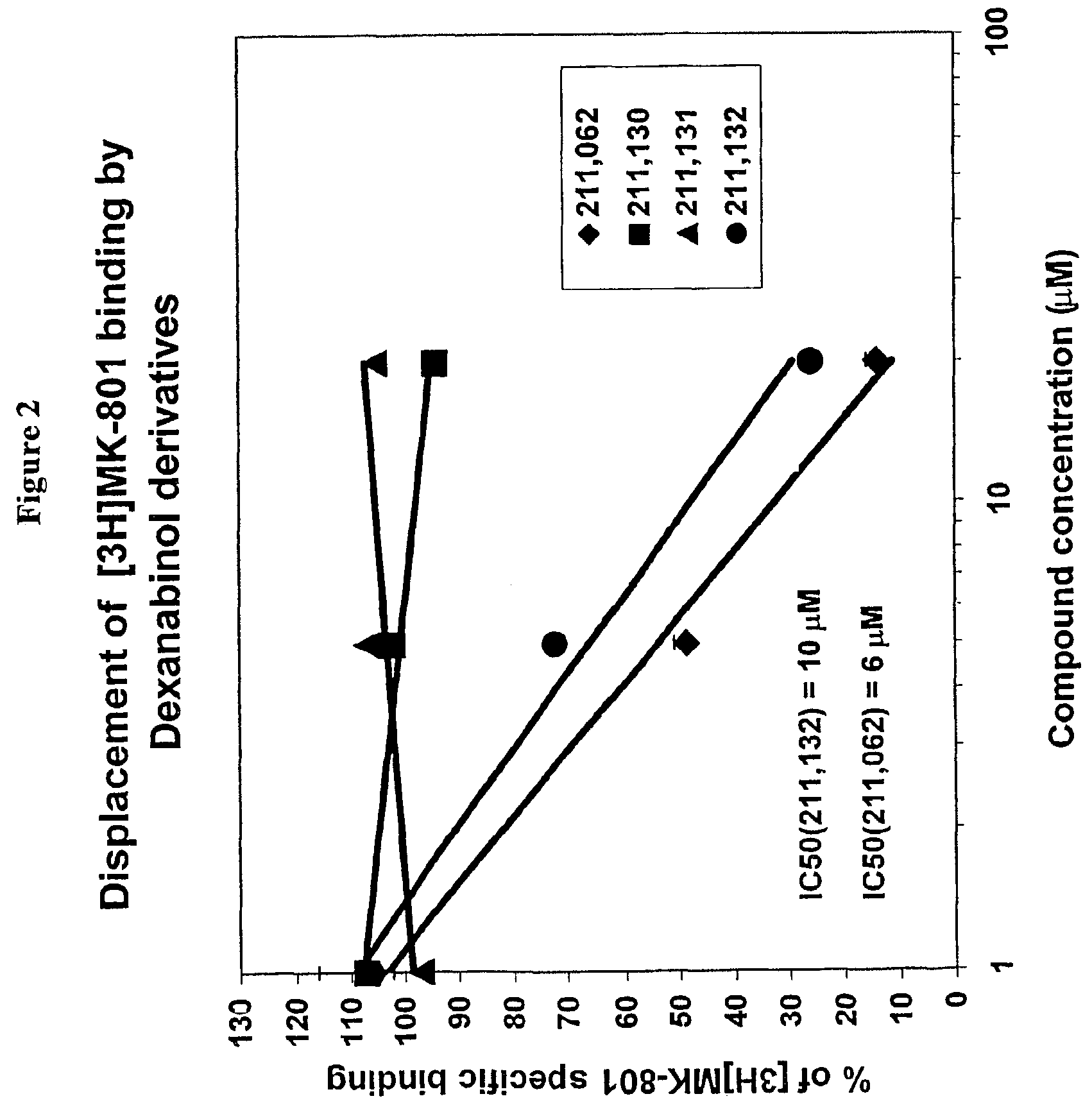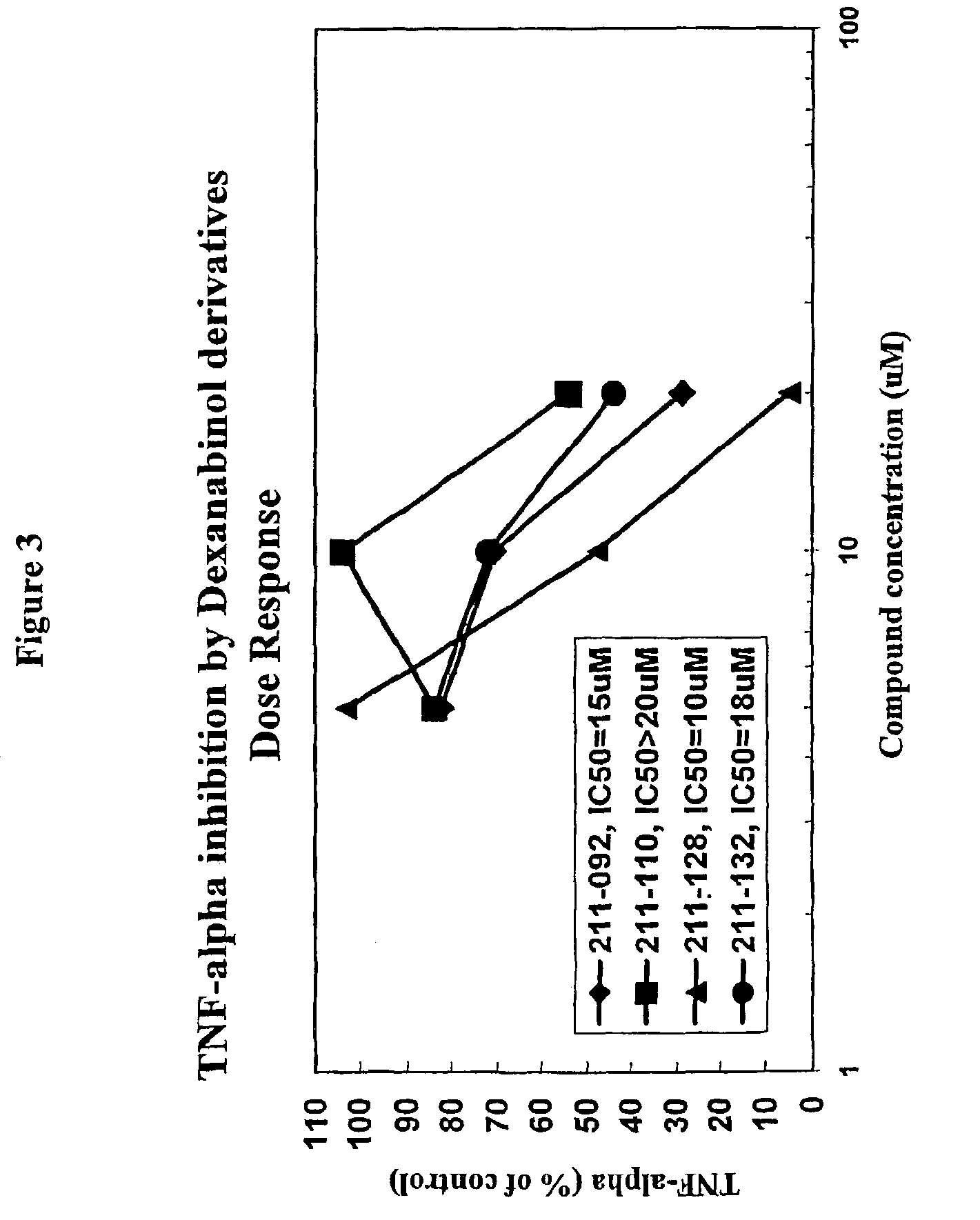Non-psychotropic cannabinoids
a non-psychotropic, cannabinoid technology, applied in the field of new non-psychotropic cannabinoids, can solve the problems of limiting its therapeutic utility, and achieve the effects of preventing neurotoxicity, reducing dependence or abuse, and reducing toxic effects
- Summary
- Abstract
- Description
- Claims
- Application Information
AI Technical Summary
Benefits of technology
Problems solved by technology
Method used
Image
Examples
example 1
Physiological Example 1
PRS-211 Analogs Analyzed by Radioligand Binding Studies
[0228]The identification of possible recognition sites for PRS-211 analogs was carried out by measuring the ability of these PRS-211 analogs to inhibit the binding of MK-801 to rat forebrain membranes. Radioligand binding studies demonstrated that the parent compound HU-211 competes with the binding of MK-801 to membranes, while it is unable to inhibit AMPA or kainic acid binding.
Forebrain Membrane Preparation:
[0229]Brains were removed from Sprague-Dawley rats no more than 5 min after decapitation. Membrane preparations were isolated according to a procedure described previously (Eshhar et al., Brain Res. 476:57, 1989). Prior to radioligand binding measurements, endogenous glutamate present in membranes was removed from the preparation by subjecting the membranes to 3–4 successive washings in 10 mM Tris HCl pH 7.2, performed at 4° C.
Radioligand Binding Studies:
[0230]The specific binding of the new analogs ...
example 2
Physiological Example 2
The In Vivo Anti-Inflammatory Effect of PRS-211 Compounds in the Ear Edema Model
[0233]The anti-inflammatory activity of the new analogs was established in the ear edema model in mice using Croton oil (CO) or Arachidonic acid (AA) as inflammation inducers.
[0234]Briefly, the animals were anesthetized and either test analog or identical volume of vehicle is injected IP. CO or AA solution diluted with acetone was injected (ear / ear) to one ear. The contralateral ear, serving as control, received an equal volume of the diluent. One to 3 hours post injection the animals were euthanized and ear thickness measurements are taken in duplicates using a low tension, spring loaded dial micrometer. The edge of the micrometer pads was placed on the outer edge of the ear. Thickness was measured in units of 0.01 mm. Tissue weight was determined by excising a 6 mm diameter disc of ear tissue from the ear lobes using a metal punch. Inflammation / Edema is expressed as the increase ...
example 3
Physiological Example 3
In Vitro Screening of Anti-Inflammatory Activity
A. Inhibition of Prostaglandin Synthesis
[0235]The inhibitory effect of Dexanabinol new analogs on prostaglandin synthesis was evaluated in macrophage cell cultures. Macrophages were seeded in a 24 well NUNC plates, and incubated with DMEM medium for 24 hours to allow attachment to plastic. The wells were vacuumed and a different new analog is added for 1 hour. Treatments are done in triplicates. Following, LPS was added for a duration of 3–24 extra hours, to induce the inflammatory response. The supernatants were collected and analyzed for PGE2 by enzyme immunoassay technique Biotrak kit (Amersham Pharmacia Biotech).
[0236]The results obtained with certain preferred novel analogs are summarized in Table 2 above.
B. Inhibition of TNFα
[0237]The method for macrophage cell culture growth is identical to the one described in PGE2 assay. Aliquots of the supernatants collected following stimulation with LPS were quantitat...
PUM
| Property | Measurement | Unit |
|---|---|---|
| temperature | aaaaa | aaaaa |
| temperature | aaaaa | aaaaa |
| pH | aaaaa | aaaaa |
Abstract
Description
Claims
Application Information
 Login to View More
Login to View More - R&D
- Intellectual Property
- Life Sciences
- Materials
- Tech Scout
- Unparalleled Data Quality
- Higher Quality Content
- 60% Fewer Hallucinations
Browse by: Latest US Patents, China's latest patents, Technical Efficacy Thesaurus, Application Domain, Technology Topic, Popular Technical Reports.
© 2025 PatSnap. All rights reserved.Legal|Privacy policy|Modern Slavery Act Transparency Statement|Sitemap|About US| Contact US: help@patsnap.com



